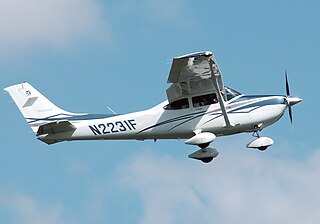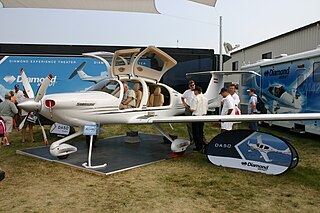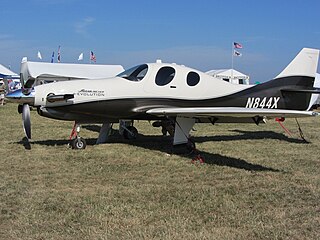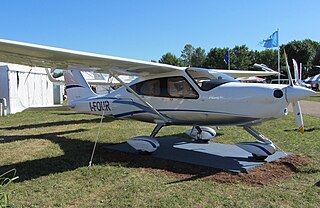
The Piper PA-28 Cherokee is a family of two-seat or four-seat light aircraft built by Piper Aircraft and designed for flight training, air taxi and personal use. The PA-28 family of aircraft comprises all-metal, unpressurized, single piston-engined airplanes with low-mounted wings and tricycle landing gear. They have a single door on the right side, which is entered by stepping on the wing.

The Cessna 182 Skylane is an American four-seat, single-engined light airplane built by Cessna of Wichita, Kansas. It has the option of adding two child seats in the baggage area.

The Lycoming O-540 is a family of air-cooled six-cylinder, horizontally opposed fixed-wing aircraft and helicopter engines of 541.5 cubic inches (8,874 cc) displacement, manufactured by Lycoming Engines. The engine is a six-cylinder version of the four-cylinder Lycoming O-360.

An electric aircraft is an aircraft powered by electricity. Electric aircraft are seen as a way to reduce the environmental effects of aviation, providing zero emissions and quieter flights. Electricity may be supplied by a variety of methods, the most common being batteries. Most have electric motors driving propellers or turbines.

The Diamond DA40 Diamond Star is an Austrian four-seat, single-engine, light aircraft constructed from composite materials. Built in both Austria and Canada, it was developed as a four-seat version of the earlier DA20 by Diamond Aircraft Industries.

The Diamond DA50 is a five seat, single-engine, composite aircraft designed and built by Diamond Aircraft Industries. First shown in 2006, it made its maiden flight on 4 April 2007. The project has been proposed to be powered by several different engines, but was certified on 9 September 2020 with the Continental CD-300 diesel.
Pipistrel d.o.o Ajdovščina is a Slovenian light aircraft manufacturer established in 1989 by Ivo Boscarol and based in Ajdovščina. Its facilities are located in Ajdovščina, Slovenia, and near the town of Gorizia, Italy. By March 2019, Pipistrel had produced more than 2000 aircraft.

The Lancair Evolution is an American pressurized, low wing, four-place, single engine light aircraft, made from carbon fiber composite, developed by Lancair and supplied as an amateur-built kit by Evolution Aircraft.

The Rockwell Commander 112 is an American four-seat single-engined general aviation aircraft designed and built by North American Rockwell starting in 1972. In 1976, they introduced the turbocharged version 112TC and mounting a larger engine with other minor improvements they introduced the Rockwell Commander 114. A total of approximately 1,300 examples of all models were produced before the production line shut down in 1980. In 1981, the type certificate owner was Gulfstream Aerospace, but that company had no interest in single-engine piston production.

The Lycoming IO-390 engine is a horizontally opposed, four-cylinder aircraft engine, manufactured by Lycoming Engines.

The Pipistrel Virus is a two-seat, single engine light aircraft, manufactured by Pipistrel in Slovenia and Italy, and sold as an ultralight, homebuilt kit, or light-sport aircraft.

The Pipistrel Sinus is a two-seat, single-engine ultralight motor glider, developed and manufactured by Pipistrel in Slovenia and Italy. Its design has served as the base for future Pipistrel developments such as the Virus and Alpha Trainer.

The Pipistrel Taurus is a Slovenian self-launched two-seat microlight glider designed and built by Pipistrel.

The Flight Design C4 is a German four seat, high-wing, single engine light aircraft under development by Flight Design of Leinfelden-Echterdingen.

The Tecnam 2010 is a four-seat, high wing, single engine light aircraft of mixed metal and carbon-fiber-reinforced polymer construction. Designed and built in Italy, it was first presented in public in April 2011.

The Pipistrel Alpha Trainer is a Slovenian two-seat, single-engine light-sport aircraft intended specifically for flight training, designed and produced by Pipistrel in Gorizia, Italy.
The Novaer U-Xc Stardream is a proposed four passenger, composite aircraft.

The Vulcanair V1.0 is an Italian light aircraft, designed and produced by Vulcanair of Casoria, introduced at the AERO Friedrichshafen show in 2014. The aircraft is type certified by the European Aviation Safety Agency and the US Federal Aviation Administration and is supplied complete and ready-to-fly.
A hybrid electric aircraft is an aircraft with a hybrid electric powertrain. As the energy density of lithium-ion batteries is much lower than aviation fuel, a hybrid electric powertrain may effectively increase flight range compared to pure electric aircraft. By May 2018, there were over 30 hybrid electric aircraft projects, and short-haul hybrid-electric airliners were envisioned from 2032.

The Pipistrel Velis Electro is a Slovenian light aircraft, designed and produced by Pipistrel of Ajdovščina. The aircraft was EASA CS-LSA fully electric type certified in June 2020 and it is intended primarily for the training aircraft role, particularly multiple successive take-off and landings at the airfield. The design is the first type certified electric aircraft and is supplied complete and ready-to-fly.


















